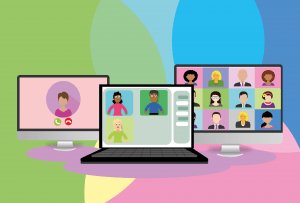Listen (10 mins) or read (6 mins)
This article is co-authored with Dr Alison Gilmour from University of Greenwich. This is an updated version. The original was posted here: https://blogs.gre.ac.uk/learning-teaching/2020/11/09/using-breakouts-in-live-online-sessions/
“When explanations make no sense
When every answer’s wrong
You’re fighting with lost confidence
All expectations gone
The time has come to make or break
Move on, don’t hesitate
Breakout”
(Swing out Sister, 1986)
The lyricists behind ‘Breakout’ were prescient, as a ‘need’ for breakout spaces within platforms used for online teaching is often seen as an essential feature for sense-making, confidence building and helping students get to the right answers. They enable students to engage with each other in ways that come close to the small group interaction of face-to-face environments. As the dust began to (very slowly) settle after the emergency response to Covid Lockdown in spring 2020, the HE sector at large heard a strong message from student for more interaction (JISC, 2020). Student engagement became a key talking point in our discussions with staff about their initial experiences of teaching in the blended mode. For those obliged to teach with Microsoft Teams, the slow roll out of breakout room functionality became a sore point as they looked jealously at colleagues who could use Zoom. In fact, given that we had been using Zoom as part of our own online programme and could no longer, we looked jealously back at our former selves for some time! ![]()
Our extensive experience of using integrated breakout rooms in equivalent platforms such as Adobe Connect and Zoom, has taught us that whilst breakout spaces do offer excellent opportunities for changing the dynamics and engaging students in different ways, they have to be used with care. This is not least in the context of webinar tools as evolving platforms, as the introduction of new features can inevitably mean glitches and inconsistencies. Imperfections or limitations in the ways tools work can also frustrate: The lack of an ability to record Zoom breakouts or for anyone other than the meeting instigator in Teams to use breakout rooms are two such examples.
Always start with the why
As academic developers, when colleagues express a desire to use a new technology, tool or feature, we normally take people back to the question of purpose. Why do you want to use breakouts, and what are you trying to achieve in terms of your students and their learning? Colleagues recently explored the question of why we may introduce breakouts and the following were at the forefront of our collective thinking:
Supporting active engagement and interaction
- To enable students who may never or rarely meet, or communicate virtually, to work together.
- To support student confidence-building through expression, and testing, of ideas within a small group.
- To purposefully bring students into discussion groups with those whom they wouldn’t normally work.
- To support contributions from people who feel uncomfortable contributing in front of a larger group.
- To support contributions from people unable to contribute due to the number of contributions within a larger group.
Supporting active student learning
- To support more interactive classes, with more opportunities for peer learning and less didactic teaching.
- To enable more student-led small group discussion of a specific topic in a small group.
- To brainstorm different perspectives and viewpoints and summarise these when back with the main group.
- To provide the opportunity for different breakout groups to work on different sub-topics of a larger issue.
- To allow a semi-private space for students to apply learning or practice.
Issues such as feeling apprehensive about who you may end up in a breakout room with, to what extent this space is ‘private’, and whether people will even talk once they get there, all reinforce our belief that this function should not be seen as a panacea for student engagement. If your students are quiet, not actively engaging and not turning their camera or microphone on in synchronous online sessions, the addition of breakouts could compound rather than change this. So, how can we set up breakouts to maximise engagement?
‘How’ Strategies
 Consider for a moment the old and fondly remembered days of heated, mask-free and packed seminar rooms. After putting your students into small group discussion, what happened next? Did you ever find that after setting the ball rolling your next 5 minutes were spent moving from group to group clarifying, cajoling or calming? ‘What are we supposed to be doing?’ is not an uncommon question in these circumstances, even when you feel you have been 100% explicit in your initial instruction for the group activity.
Consider for a moment the old and fondly remembered days of heated, mask-free and packed seminar rooms. After putting your students into small group discussion, what happened next? Did you ever find that after setting the ball rolling your next 5 minutes were spent moving from group to group clarifying, cajoling or calming? ‘What are we supposed to be doing?’ is not an uncommon question in these circumstances, even when you feel you have been 100% explicit in your initial instruction for the group activity.
Now consider the difference between that scenario and setting the same activity in an online breakout space. Of all the potential issues, the biggest is likely to be students suddenly finding themselves in a smaller group, in a virtual space in which their tutor isn’t immediately present to clarify, and uncertain about what they should be doing. It is of course possible to request help, but the mechanisms for this are less obvious than getting your attention in the physical classroom. To that end, in any breakout scenario the following ‘rules’ are generally helpful to apply. Before putting your students into breakout rooms, tell them:
- why they are going into small groups;
- who they will be in breakout groups with or clarify that this is randomly allocated (if it is);
- how long they will be in the breakout activity;
- clear instructions for the task;
- that what they say is between them unless you join their breakout but you can see meeting notes/ the chat;
- if you are likely to pop in;
- that they can message you (remind them how to do this);
- to look out for messages from you in the chat; and
- if you are allocating roles (e.g. note takers) to support the discussion upon returning to the main call.
Avoiding assumptions
Even with this guidance, we need to acknowledge that we can’t assume students know how to engage with each other virtually and in breakout rooms. Breakouts can certainly be useful in developing student confidence in speaking but we shouldn’t assume that they will be either willing or able to turn on microphones (let alone cameras).
- You may want to have a pre-breakout activity exploring with students a commitment to ways in which they may engage respectfully and productively in breakout spaces and with acknowledgement that not everyone may be able to participate in the same ways.
- We always suggest a note taker is nominated. In Teams we suggest that they use ‘chat’ rather than in-meeting notes (as then everyone in the breakout has access to them after the session, unlike meeting notes). In Zoom the same does NOT apply so it is worth considering where notes might be taken if they are likely to be needed later (eg. a collaborative document).
- You might want to consider techniques for determining if and how you will get ‘volunteers’ for feeding back in plenaries, and identifying this role before the breakouts.
- It’s worth noting that a frequent face-to-face teaching complaint from students is that plenaries are dull, especially if every group is covering similar points. Is a plenary beyond a general chat necessary at all? Can you use the chat feature to get a delegate from each breakout to share two key points instead? Or could you use a Mentimeter poll to which each group contributes and you as facilitator in the main room can pick up on some key points for further discussion in the plenary? Such approaches mean that plenary responses are captured in the written form for students and can be accessed after the class or shared on Moodle.
 When designing teaching and learning for blended modes, we repeatedly emphasise purpose, signposting and avoiding making assumptions about our students’ abilities or confidence. In this sense, breakouts are no different from the guidance for any other tool or platform you are considering introducing to your teaching. Be prepared for glitches and having to think on your feet. In terms of pedagogy, it may prove for many that the bigger ‘breakout’ needed is from our own assumptions and mindset about how we teach and manage online spaces. Nevertheless, finding the right balance between relinquishing control and offering structure and coherence in breakout spaces can be tricky but ultimately rewarding.
When designing teaching and learning for blended modes, we repeatedly emphasise purpose, signposting and avoiding making assumptions about our students’ abilities or confidence. In this sense, breakouts are no different from the guidance for any other tool or platform you are considering introducing to your teaching. Be prepared for glitches and having to think on your feet. In terms of pedagogy, it may prove for many that the bigger ‘breakout’ needed is from our own assumptions and mindset about how we teach and manage online spaces. Nevertheless, finding the right balance between relinquishing control and offering structure and coherence in breakout spaces can be tricky but ultimately rewarding.
Martin Compton & Alison Gilmour (June 2021)